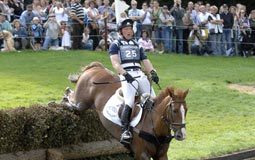
Reality Check
To begin to set attainable goals, you first need to be very honest about both your and your horse’s abilities. If your goal is to be showing in the Grand Prix ring and you currently show in the 3-foot jumpers, it may be a bit longer than a year for you to jump at that height.
Additionally, you’ll need to be very realistic about what your horse can do versus what you would ultimately like to achieve. While your horse may do just fine at the lower levels of dressage, accepting that he is not physically able to do the Prix St. George is important so you don’t place unfair expectations on him. By the same token, if you have a young horse, you can’t expect him to act like a seasoned pro every time he sets foot off the farm.
It’s also important to be cognizant that major improvements take time (and patience!). You won’t be able to fix everything all at once, but by paying attention to the little improvements at each show, you’ll feel more encouraged.
Setting Small Goals
Once you’ve taken a hard look at what both you and your horse are capable of, it’s time to sit down and determine what you would like to accomplish this year. Enlist your trainer to help you set goals; she will be able to look objectively at what you want to achieve and let you know if it’s realistic.
Try to avoid generalized, overarching plans, like “I am going to have a perfect trip in the equitation over fences class.” It’s much more helpful to set very specific goals, such as, “I am not going to drop my inside shoulder in the turns” or “my horse is going to get a clean lead change and not cross canter for 10 strides.”
A good trainer will take your bad habits and make improving them a priority. Do you ride with limp wrists? Do you look down at your leads or do you not look around your corners? Your trainer will help you pick out what you need to work on and make it a goal to improve on them at each show, though maybe not all at once. These things seem minor, but they affect the way your horse goes, so fixing these small bad habits will improve your horse’s performance at every show.

These very distinct goals allow you to track your progress from show to show, no matter what venue you’re in, who else is in your class, what the weather is like or even who is judging you. Write down your goals before the show and review them (in writing) immediately after the show, when everything is still fresh in your mind.
Some of these goals might include:
- Controlling show nerves (both you and your horse!)
- Getting a clean lead change
- Having your horse connected during his entire dressage test
- Preventing a spook by shifting his focus
- Riding straight between jumps
- Riding deep into corners
- Not grabbing your horse in the mouth
- Cantering from a walk with no trot steps
- Remembering your pattern
- Relaxing and having fun
Setting show-by-show goals doesn’t mean not having a long-term plan; it simply means that you understand the process of achieving your goal starts with small steps. Breaking down end goals into bite-sized piece means that both you and your horse don’t get overwhelmed or discouraged.
The true point of horse showing is to have fun and to ride to the best of your (and your horse’s) ability. Placing is just the icing on the cake.
Based in Lexington, Ky., Sarah Coleman has a young OTTB she is retraining to be a hunter. Her show-by-show goals for this year include learning walk to canter transitions, going forward to the fences and nailing left-to-right lead changes.






Good advise, hope kI can do it all. Specially, the nerves.
Thank You will see if these tips will work, or even if I will remember them all when I get nervous before the show. Think Positive!!